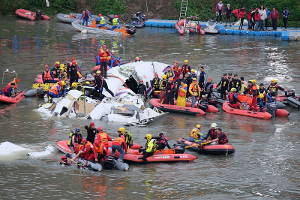Air transport, even safer in 2015
 Plane crash in Taiwan © 玄史生 , CC BY-SA 3.0 Plane crash in Taiwan © 玄史生 , CC BY-SA 3.0 |
In the past year, 68 plane crashes involving all kinds of aircrafts have been reported, only four of which caused the disappearance of passengers and crew members. In comparison with 2014, the year 2015 in terms of air transport reported a 79% decrease in deaths which went from 641 to 136, while the number of accidents dwindled down to 13%.
For the record, the annual average for the recent five years (2010-2014) is set at 90 accidents, 17.6 of which are deadly, with 504 people killed.
With one major crash for 3.1 million flights, the rate of global loss history, measured by the number of hull losses per million of flights, is set at 0.32. This percentage is improving by 30% in comparison with the 2010-2014 period under study.
As a reminder, 3.5 billion passengers travelled in 2015 on board of 37.6 million flights around the world.
The IATA's survey ruled out the two deadliest events of 2015, that is, the crashes of Germanwings and Metrojets. Both catastrophes were characterized as deliberate acts of “unlawful interference” and not as the result of a hazard.
On March 24, an A320 airbus of the airliner Germanwings, subsidiary of Lufthansa, crashed in the French Alps. The investigation found that the co-pilot deliberately crashed the aircraft against the mountain.
Late October, a Russian plane of the company Metrojet crashed in Sinai, Egypt with 224 passengers on board. Characterized as a terrorist attack, the event was triggered by the explosion of a device embarked on board. Both crashes claimed the lives of 374 passengers and crew members, bringing the actual total number of deaths in 2015 to 510 people.
Air transport safety at the regional level
The global rate of air travel safety has improved tremendously in recent years. Measured by the number of hull losses in million flights, this percentage dwindled down in all areas of the globe in 2015, except in North America.
Africa, whose loss history index (3.49) remains much higher than the global average (0.32), has posted notable improvement of this indicator in comparison with the five-year average set at (3.69).
For the Middle East and North Africa, this index is of 0% compared to the 1% average reported over five years.
Air transport: Rate of hull losses per region
| Region | 2015 rates | Annual average rate 2010-2014 |
|---|---|---|
Africa | 3,49 | 3,69 |
Asia-Pacific | 0,21 | 0,56 |
CIS | 1,88 | 3,14 |
Europe | 0,15 | 0,18 |
Latin America and the Caribbean | 0,39 | 0,92 |
Middle East and North Africa | 0 | 1 |
North America | 0,32 | 0,13 |
North Asia | 0 | 0,06 |
Sub-Saharan African companies reported four hull losses in 2015, two of which involving planes powered by jet engine:
- In Congo, a cargo plane made a runway excursion causing the death of 8 people,
- In Senegal, an air collision between an airliner and a small jet (a medical evacuation flight) claimed the lives of 7 people.
Air transport: main air accidents having occurred in 2015
| Date | Location | Type of aircraft | Company | Number of deaths | Cause |
|---|---|---|---|---|---|
| 4/11/ 2015 | Juba, South Sudan | Antonov AN-12BK | Allied Services, South Sudan | 40 | Unknown |
| 31/10/2015 | North Sinai, Egypt | Airbus A321-231 | Metrojet, Russia | 224 | Terrorism act |
| 16/08/2015 | Oksibil, Indonesia | ATR 42-300 | Trigana Air | 54 | Unkown |
| 30/06/2015 | Medan, Indonesia | Lockheed C-130 Hercules | Indonesian Air Force | 113 on board and 22 on ground | Problem in one of the four propellers |
| 29/03/2015 | Halifax, Canada | Airbus A320-211 | Air Canada | 0 | Bad weather conditions |
| 24/03/2015 | Barcelonnette, France | Airbus A320-211 | Germanwings | 150 | Suicide of the co-pilot |
| 04/02/2015 | Taipei, Taiwan | ATR 72-600 | TransAsia Airways | 43 | Failure of the right engine |
